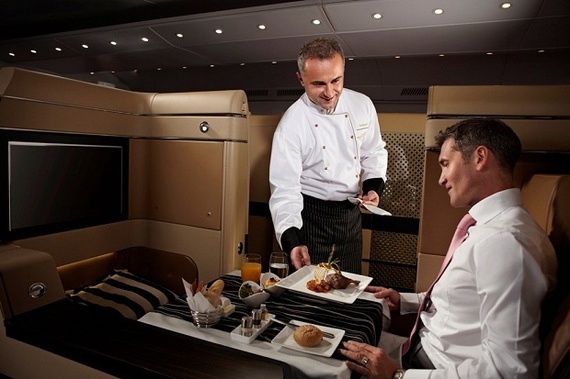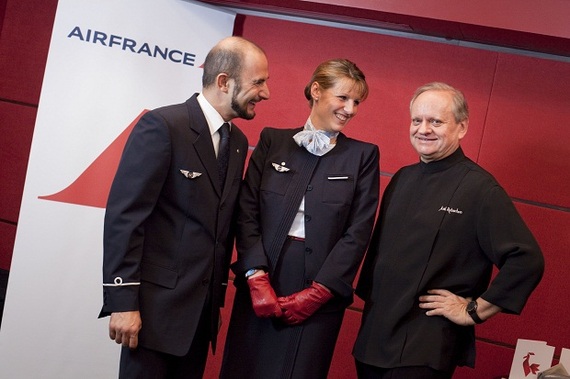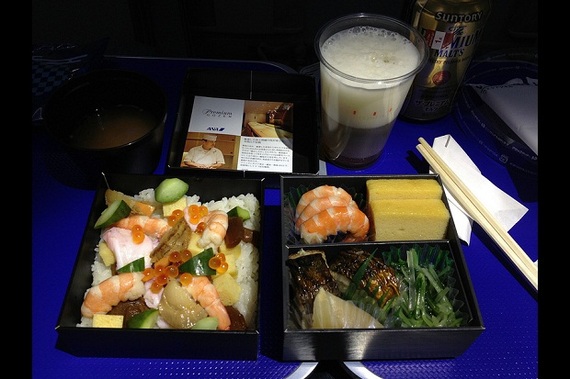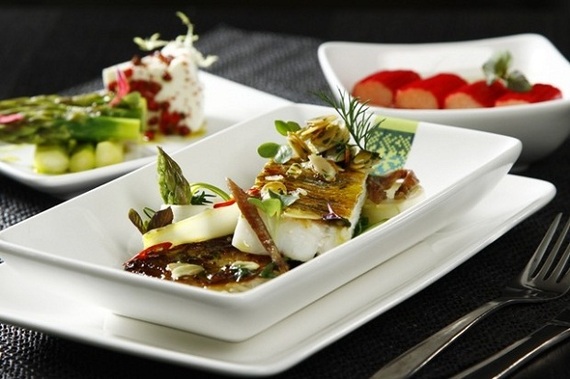Onboard space constraints, limited convection ovens and a major lack of ambiance all detract from the enjoyment of skillfully prepared in-flight cuisine. But the parties who provide airline food won't let fliers' dining experiences become subpar. Over the past few years, airlines across the globe -- from US Airways to the United Arab Emirates' Etihad Airways -- have reinvented ways to serve up savory mile-high meals. To bring you what's innovative (and delicious) in in-flight fare, U.S. News Travel spoke with two industry insiders: corporate executive chef Bob Rosar of airline catering company Gate Gourmet and Sue Ling Gin, founder and CEO of fellow in-flight food provider Flying Food Group. Prepare to have your taste buds taken to new heights with these seven growing trends.
[In Pictures: Top Trends in Airline Food]
Organic Meals
Travelers are increasingly in search of healthier in-flight food options, according to a joint survey from airline food site Inflight Feed and the women business travel group Maiden Voyage. Flying Food Group's Gin says she sees evidence of that nutritious trend in the uptick of fliers eating fish, white meat chicken and other lean proteins. Side dishes have also taken a particularly wholesome turn: "Grains have become very popular and greens have become very popular. I think that's sort of a sign of the times," Gin said. "People want to eat healthy, but they want to have something that's kind of special or something maybe that they wouldn't have at home." Kullaflyg, a small Sweden-based airline with an environmentally friendly mission, capitalized on this diet-conscious trend by providing economy class passengers with organic in-flight meals. The airline obtains its food and beverage items from local farms, bakeries and other nearby businesses, and prepares all meals on each flight's day of departure. Similarly, Air Canada's NutriCuisine menu was developed through a partnership with the healthy eating program, Food with a Conscience. The program, which debuted in 2009, adheres to low-sodium, additive and preservative-free standards, among other guidelines. For those watching their weight, Virgin America includes calorie counts and nutrition information on their in-flight menus.
Personal In-flight Chefs
It should come as no surprise that the United Arab Emirates' penchant for luxury translates to its international airline, Etihad Airways. In the Diamond First Class cabin on most of Etihad's international flights, fliers are greeted by a formally trained chef who promises to handcraft meals that meet the needs of each passenger. Enlighten the culinary artist with your taste preferences and dietary restrictions, and he or she will recommend something on the menu or prepare a custom-made dish. Passengers can choose from more than 30 diverse dishes, including delicate appetizers like Arabic Chickpea Soup and made-to-order grill items (think lamb shank or rib-eye steak with your choice of sides and sauces). Other airlines provide similar programs, like Turkish Airlines' Flying Chef service, though few in-flight chef services have been lauded quite as much as Etihad's; the airline won the 2012 World Airline Award for Best First Class Onboard Catering. But to get a taste of this level of luxury, it'll cost you: A one-way trip in Diamond First Class from Washington Dulles International Airport (IAD) to Abu Dhabi Airport (AUH) on Etihad Airways will set you back about $10,000.
[See: 10 Best Cities for Foodies]
Celebrity Chefs
With shows like "Top Chef" and "Chopped" enhancing the flying public's foodie knowledge it's no wonder airlines recruit celebrity chefs to add some pizzazz to in-flight menus: Gate Gourmet's Rosar says today's fliers are more educated on food than they've ever been. Since 2011, Air France has enlisted the expertise of notable French chefs to design mouthwatering dishes for its business and first class cabins. The airline kicked off its Studio Culinaire Servair team with Michelin-starred culinary kingpin Joël Robuchon, and has featured a rotation of famed cuisiniers ever since. Air France's newest menu includes insight from chef Thibaut Ruggeri, head honcho of Parisian foodie hotspot Lenotre. Ruggeri's dishes will be served on board long-haul flights through May 2014. American Airlines cashed in on the star-studded trend by teaming up with chef and restaurateur Richard Sandoval and Food Republic co-founder Marcus Samuelsson to help craft onboard menus. Meanwhile, Singapore Airlines has consulted with Gordon Ramsay to offer inventive culinary offerings on fights.
Pre-ordering Meals
On flights to more than 24 international destinations, US Airways gives passengers the option to upgrade standard, complimentary meals in economy class for something with a little more flavor. In lieu of included onboard meals, fliers can pay $21.99 for a DineFresh chilled meal box featuring foods like vegetarian orzo with portobello mushrooms or marinated lime chicken breast; each comes with pre-determined side dishes, salads, snacks, desserts and one mini-bottle of wine. US Airways touts itself as the first airline to offer this premium meal reservation service, which began operating in August 2012, but other airlines have since picked up on the trend. Delta Airlines' similar DineUp program offers advanced premium meal orders of cold entrees and salads for prices ranging from $11.99 to $17.99. American Airlines followed suit with its pre-order service. Rather than upgrading economy meals, American's system is meant to ensure that first and business class passengers receive their entree preferences rather than be told on board that there's not enough shrimp curry to go around.
Culture-focused Cuisine
While destination-inspired cuisine is not necessarily a new idea in airline fare, the importance of culture-specific menus is as important as ever to travelers. In business and first class cabins on All Nippon Airways' flights from Japan to Paris, for example, the Japanese airline offers menus of steamed rice dishes, sushi and other indigenous cuisine, alongside a menu of prosciutto ham and beef stew to suit the needs of its Parisian passengers. Tourists often appreciate the opportunity to embrace their upcoming destination with an early taste of an arrival city's cuisine. With this in mind, Flying Food Group strives to design meals that include familiar flavors for fliers around the globe. And according to Gin, that kind of versatility in cultural dining options can be essential to a traveler's comfort. "In anticipation of going to ... Tokyo they might order a Japanese meal or they might not, because it was a tough day at the office and they just might want comfort food that they know and understand," she said.
Mini-meal Options
Chef Rosar, who has been working on a recipe for the perfect in-flight dessert soufflé for years, knows that it's not always the main entree that packs the biggest in-flight punch. To quell desires for satisfying-yet-light grub, the peanuts and pretzels of airline-aisle infamy are being replaced with intricate snacks that more closely resemble mini-meals. Virgin Atlantic's Graze menu (offered in its Upper Class seats on select flights since 2012) features items like vegetarian sushi or beef sliders to assuage cravings. In premium cabins on its long-haul flights, United Airlines offers enhanced snacks like Asian-style noodle soup and small sandwiches. And it's not only premium cabins seeing more creative refreshment options; even economy menus are moving toward more satiating mini-eats (though they come with a fee). Alaska Airlines, for example, features a small Mediterranean quinoa salad for $6 and a cheese and fruit platter for $7.
Meals by Design
Despite producing close to 250 million meals annually, Gate Gourmet acknowledges that the company does face limitations in food variety on any given flight. "We don't have the luxury of having a lot of different options to offer our passengers, just because of the space," Rosar said, noting that petite galleys and flight attendant needs must be taken into account when developing recipes. There's a pretty good chance that a set sandwich-cookie-drink combo will include some things you love and some things you could live without. AirBaltic is rectifying that problem with its unique style of pre-flight meal reservations, offering a twist on the aforementioned services offered by US Airways and Delta. In advance of a flight that's 1½ hours or longer, fliers can use airBaltic's online system to add individual items to a virtual food tray. Passengers can choose from nine different salads, nine cold starters, nine meat dishes and nine seafood entrees, plus additional diet-accommodating options. After tacking on a favorite alcoholic or non-alcoholic beverage, fliers can await a personalized meal delivered at 35,000 feet. Of course, there's no such thing as a free midair lunch: These options come with a price tag of up to €25 (about $34) per item for economy cabin travelers.
[In Pictures: Top Trends in Airline Food]
-- Allison Michaels



